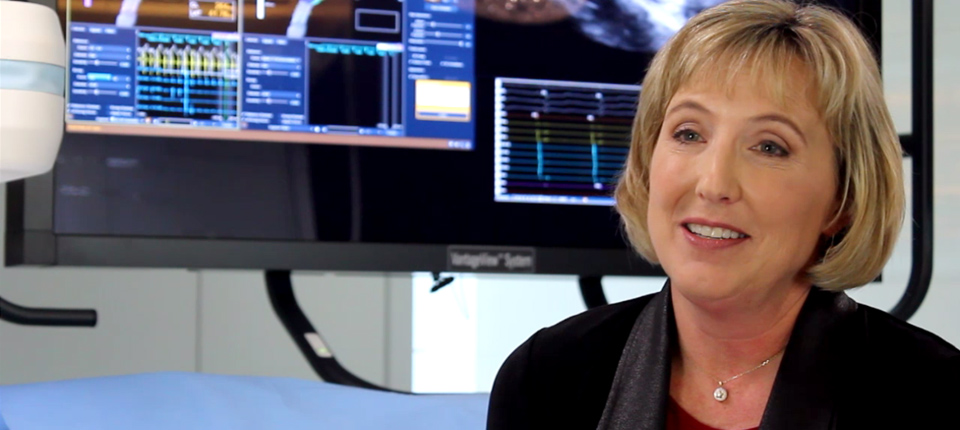
Abbott VP Challenges Herself And Others To Make An Impact
How did a ceramics engineer climb the ladder to vice president of regulatory affairs?
June 18, 2019
- Copy Link
- Share on X
- Share on Facebook
- Share on Linkedin
When Ann Graves was in high school, she considered many possible career paths. From journalism to nursing, she had a natural curiosity that led her to imagine several different options. That same curiosity would prove to be her biggest asset — combined with strong math and science skills, this trait eventually opened the door for Graves to the world of engineering and a dynamic career in healthcare.
After 30 years in the workforce, Graves is more passionate than ever about her job and the impact that STEM students can have in healthcare. Today, she is Abbott's divisional vice president of regulatory affairs for the Cardiac Arrhythmia and Heart Failure business. Although she now makes her scientific contributions outside the lab, her work highlights just how much STEM roles are changing and spurring advancement in the healthcare industry.
So, how did she move up the ranks from engineer to DVP, and what's her best advice for STEM students considering careers in healthcare?
Stepping Out in STEM
During high school, Graves sought advice from teachers and family members about possible career paths. Her oldest brother — a mechanical engineer — suggested she consider engineering. Her work would have real-life applications and she would be at the forefront of innovation. Plus, she would stand out as a woman in a male-dominated field. In fact, he told her, some people believed women couldn't succeed as engineers.
"That comment — I took that as a challenge," she says. "I had one precalculus class in high school and didn't know what the engineering curriculum would be like. I'm amazed I had the guts to do it."
In college, Graves explored different engineering fields, but it wasn't until she attended a seminar with an enthusiastic professor that she found her niche: materials engineering.
"This guy was bouncing bowls off the stage and talking about how ceramic engineers create new materials that can be used for everything from space shuttles to medical devices," she recalls. "Then, he put a big piece of glass over two chairs and started jumping on it. When it didn't break, he used a pair of pliers to barely bend the top corner, and the whole thing just shattered across the stage."
And that was all it took. After speaking with the professor post-demonstration, her love for ceramic engineering was born. Soon, she linked up with a Ph.D. student to learn as much as she could about biomaterials and what they can offer the medical field.
"Working with her in the lab got me very interested in using materials in medical devices that could really help people," Graves says.
Evolving Her Career
After graduation, Graves worked in R&D at a company creating high-temperature technologies. She enjoyed the job and learning from her brilliant, dedicated co-workers, but after four years, she was ready for a new challenge. At that point, she remembered how a family member had once advised her to change jobs every few years, no matter what, so that she would always be learning and growing.
"I thought that advice was nuts at first," Graves says. "But when I hit the four-year mark, I really needed a change. I applied for an R&D position, but they called me and said, 'We actually think you'd be a better fit for operations. We have a special project that a ceramics engineer would really fit well in.'"
Graves was hesitant to make the jump from R&D to operations, but she decided to accept the job.
"I was very uncomfortable for the first six months," she says. "Everything was so different. I was coming into a new field in a very controlled industry. This was in 1992, and people were starting to use computers and pagers, and communication was suddenly moving faster."
Soon, Graves was tapped to help open a new operations facility and be a project manager for a new heart valve product. After four years in that particular role, she wasn't looking for change. She loved her job, her colleagues and the exciting projects she worked on.
So, when a colleague from regulatory affairs called and suggested she join his department, she was quick to shut down the idea. However, when he explained exactly what the department did, Graves changed her mind and (once again) her career path.
Finding STEM Success
What does it take to succeed in regulatory affairs? First and foremost, a STEM background.
"I'm a little biased," Graves admits. "I typically go after somebody in engineering, because of the problem-solving mindset. We've brought in people with chemistry and biology backgrounds, but it's always science-based, because the job requires speaking with R&D and understanding highly technical concepts."
Still, she doesn't expect her team to know everything. In fact, she wants them to ask questions.
"You have to be inquisitive and brave enough to ask questions because there's a lot of different jargon used in the medical device world, and you don't always know what they're talking about. You also have to be very honest about what areas you're not so strong in and ask for help. Transparent communication is very helpful."
Ultimately, Graves' most important career advice is to never get too comfortable.
"Don't be afraid to try something, even if it's not exactly what you thought you would be doing. You don't have to do it for your whole career. In fact, you shouldn't. Getting siloed too soon into one function can be a disadvantage. It is scary to venture into the unknown, but you can figure it out, and there are always resources available if you need help, especially at a company like Abbott."